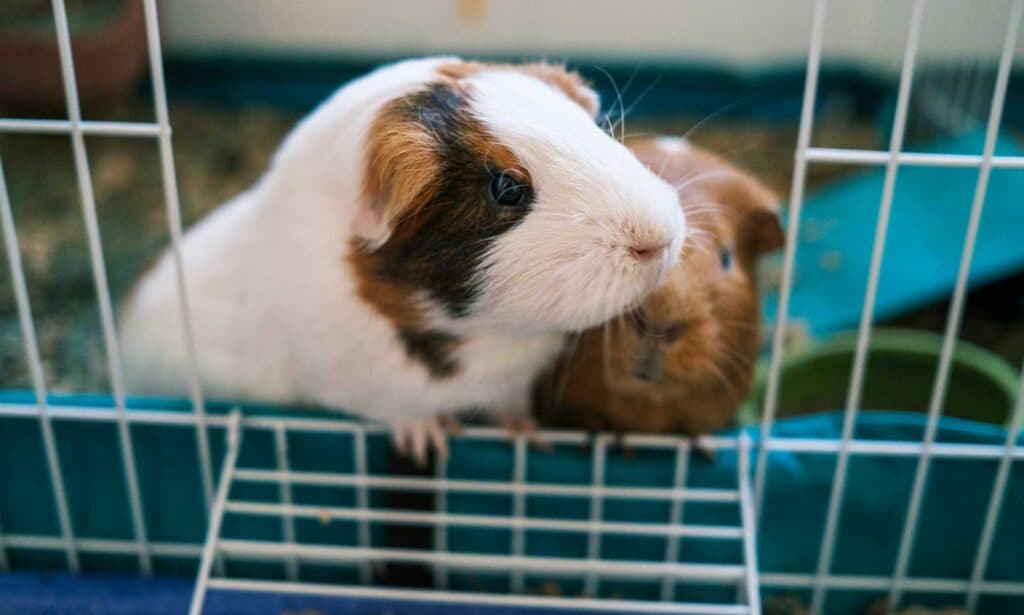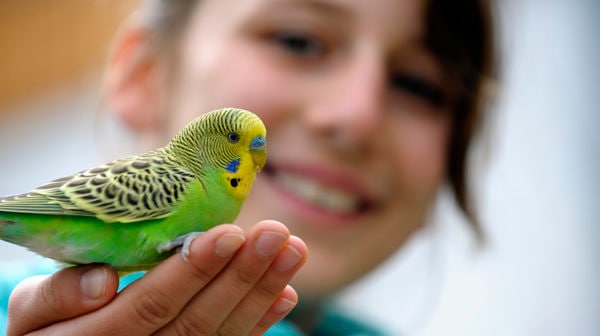Congratulations on your new piggie! These pocket pets may be small, but their overall care, including their housing, requires careful consideration to help keep them happy and healthy. Looking for guidance on where to start?
We spoke with veterinary experts about housing for guinea pigs—from essential supplies to tips on where to keep their enclosure and how to clean it.
In This Guide:
Supply Checklist
- Habitat
- Bedding
- Food and water sources
- Exercise spaces
- Hideouts
- Mental stimulation (e.g., toys)
- Litter box (optional)
Cage
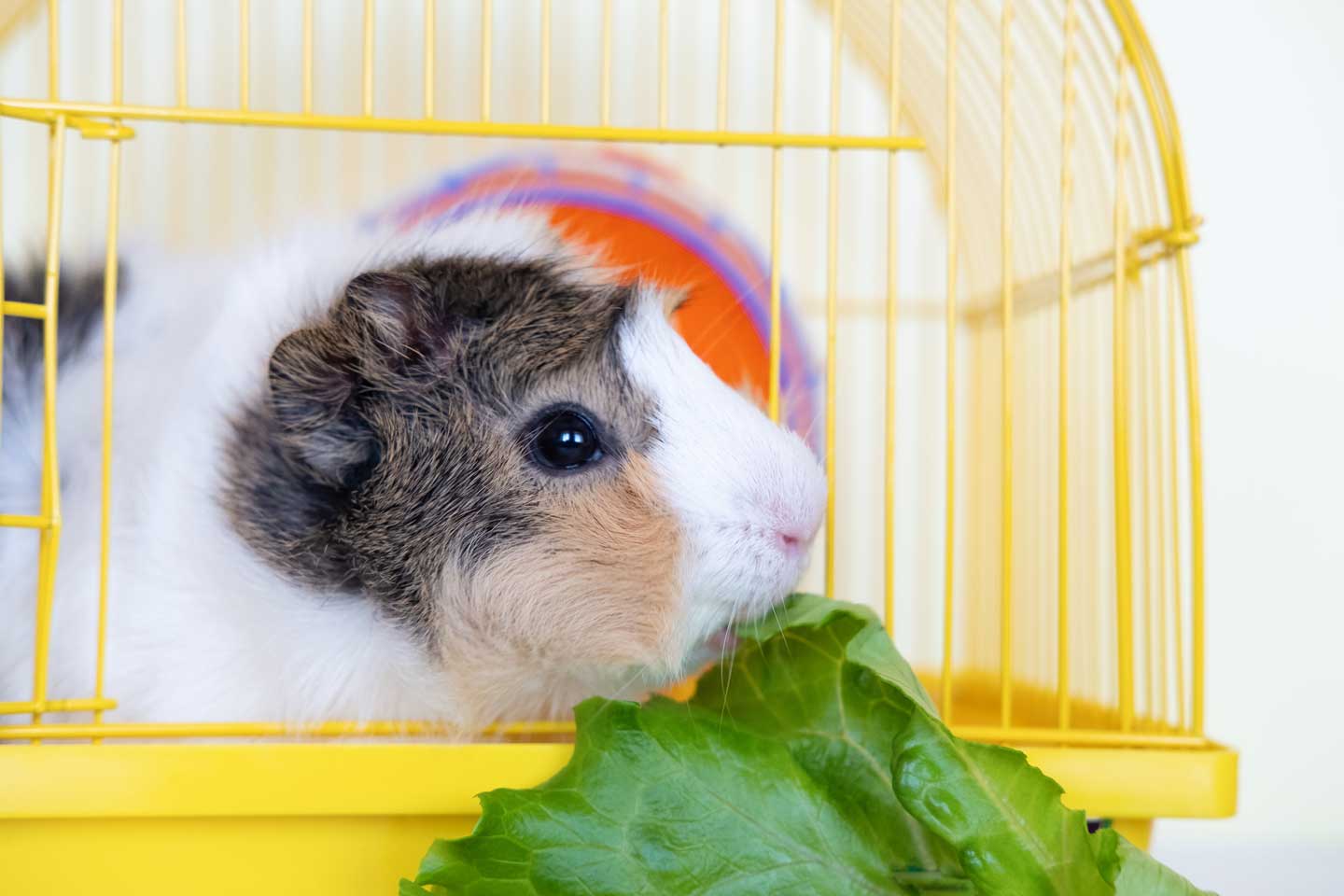
Many guinea pig cages are approximately 2 feet by 4 feet (8 square feet) in size or smaller, says Sari Kanfer, DVM, owner of Exotic Animal Veterinary Center in Pasadena, California. This is the minimum size for 1–2 guinea pigs and could serve as their habitat space. However, they’d need a larger penned area for their daily exercise, she says.
Another option is providing a larger living area around 6 feet by 10 feet (60 square feet) so there isn’t a need for an additional exercise space. That way, your guinea pig would have enough space for exercise—including popcorning and zoomies—at any time.
Guinea pig cages typically have wire or plastic sides. Some pet parents take a DIY approach and build their guinea pig’s home using C&C cages, which stands for cubes (grids) and coroplast (a plastic base). Whatever you choose, your guinea pig’s living space should have a flat bottom made of plastic or metal that's covered and padded, because guinea pigs shouldn’t be on wire flooring. Dr. Kanfer adds that guinea pigs should be housed indoors to keep them safe from injury, heatstroke, and predators.
Bedding
There are several bedding options to use in your guinea pig’s habitat. Dr. Kanfer says this can be a soft, shredded paper or, better yet, use fleece to cover the entire flooring.
She recommends steering clear of wood shavings, like pine or cedar. “They contain chemicals that can be irritating or toxic to the lungs and liver,” she says. “Wood bedding of any type can be rough on guinea pig feet.”
When deciding on a guinea pig bedding, consider whether you’d rather wash a fleece liner or simply throw away your paper bedding when it’s time to clean it. Regardless of which you decide to use, it'll need to be changed when it's soiled, which can be as often as daily. Maintaining a hygienic environment is crucial to prevent health issues.
Exercise Spaces
Despite their small size, guinea pigs need more exercise space than you might think, Dr. Kanfer says. Proper exercise “will keep their feet healthy, help their joints stay lubricated, and avoid obesity,” she says. “Plus, it allows for more mental stimulation and leads to happier guinea pigs.”
Many pigs do best in a large playpen where they get more floor space than a standard cage can provide, says Lyle Cleary, DVM, veterinarian at The Center for Avian and Exotic Medicine in New York City. You can even put the playpen around their cage, adding a ramp to the entrance to the cage so your guinea pig can enter and exit freely, he says.
The designated exercise area will need to be guinea pig-proofed for their safety. This includes covering or hiding wires they can come into contact with, and making sure there aren’t spaces they can get stuck under or furniture they may get trapped behind, Dr. Kanfer says. What’s more, guinea pigs may not want to walk on tile or wood floors since they prefer secure footing, like carpet.
Want to let your guinea pigs roam free in your home for a few hours? Dr. Kanfer says this is acceptable if they’re supervised. When you’re not able to keep an eye on them, place your guinea pigs in a safe enclosure.
Food and Water Sources
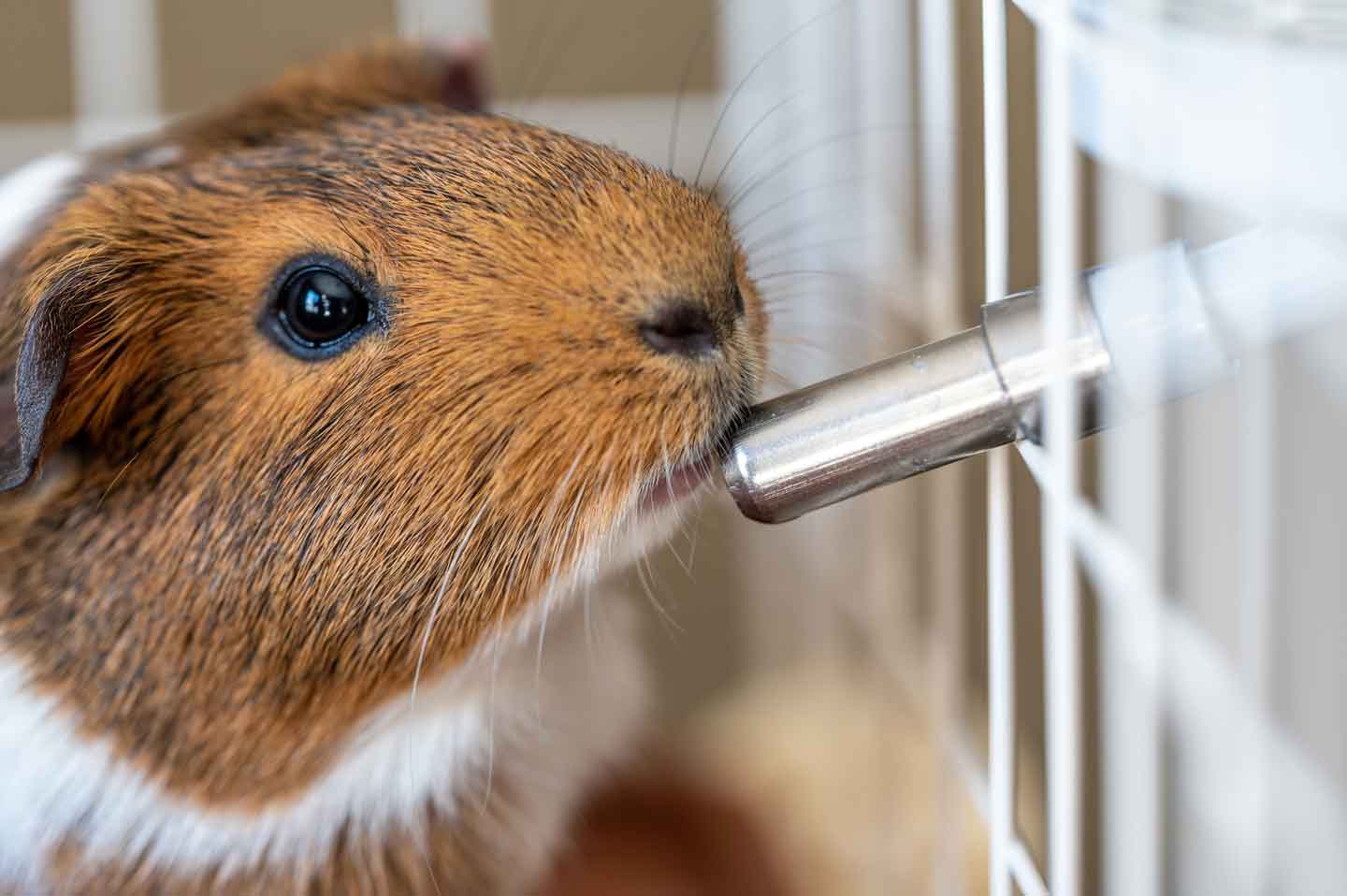
High-quality hay—such as timothy, oat, or orchard—should always be available and fed every day, Dr. Kanfer says. Your guinea pigs should have constant access to hay and should never run out. You can use hay feeders to keep food in their enclosure; just make sure they’re big enough to last between refills.
When it’s time to feed your guinea pig their pellets, Dr. Kanfer recommends placing them in a ceramic crock to keep them from getting soiled. While some cavies will only eat as many pellets as they need, others can be prone to overeating, so it’s best to limit the amount to ⅛ cup of pellets per guinea pig daily. Additionally, give fresh vegetables daily and throw away any that are uneaten after it’s been hours since they were fed.
“Guinea pigs should ideally have their water supplied in a water bottle,” Dr. Kanfer says. “When guinea pigs have bowls of water, the bowls tend to get dirty quickly.” Additionally, make sure the water bottle is working properly and hasn’t gotten blocked, which prevents your piggie from getting water.
Toys
Without physical activity and mental enrichment, every day can feel like “Groundhog Day”—even to guinea pigs.
“Living in a small cage all day can be boring,” Dr. Kanfer says. “Guinea pigs need mental stimulation and exercise.”
To keep a guinea pig active and entertained, she recommends providing them with the following:
- Tunnels
- Blankets
- Snuffle mats
- Cardboard boxes
- Guinea pig toys, and items that encourage chewing and exploring
Hideouts
Guinea pigs are prey animals, so it’s important to help them feel safe by providing a place to hide. There are many hideout options to choose from, including plastic igloos; corner fleece; timothy or twig tunnels; plywood huts; and even cardboard houses.
Dr. Kanfer considers plastic “pigloos” to be good options for guinea pigs. She says it’s ideal to have one hideout per piggie. If their hideout is placed on the cage bedding, Dr. Kanfer says no additional bedding is needed. She adds that guinea pigs do appreciate beds, so it may be worth considering placing a comfy bed somewhere else in their habitat too.
Litter Box
Cats aren’t the only pets who can be trained to use a litter box—so can guinea pigs!
If you’d like to place a litter box in your cavy’s enclosure, Dr. Kanfer says to look for a corner litter box with a low entrance. You could use recycled wood and paper fiber, like Carefresh®, for dust-free, absorbent bedding and place a layer of hay on top, she says. Then, place a hay feeder or hay bag on the inside wall of the litter box. That way, they can eat and do(o) their business simultaneously.
While this will help keep most of their poop and pee contained in one place, there’s a good chance they may also potty on the fleece liner as well, Dr. Kanfer says.
Where To Keep Your Guinea Pig Enclosure
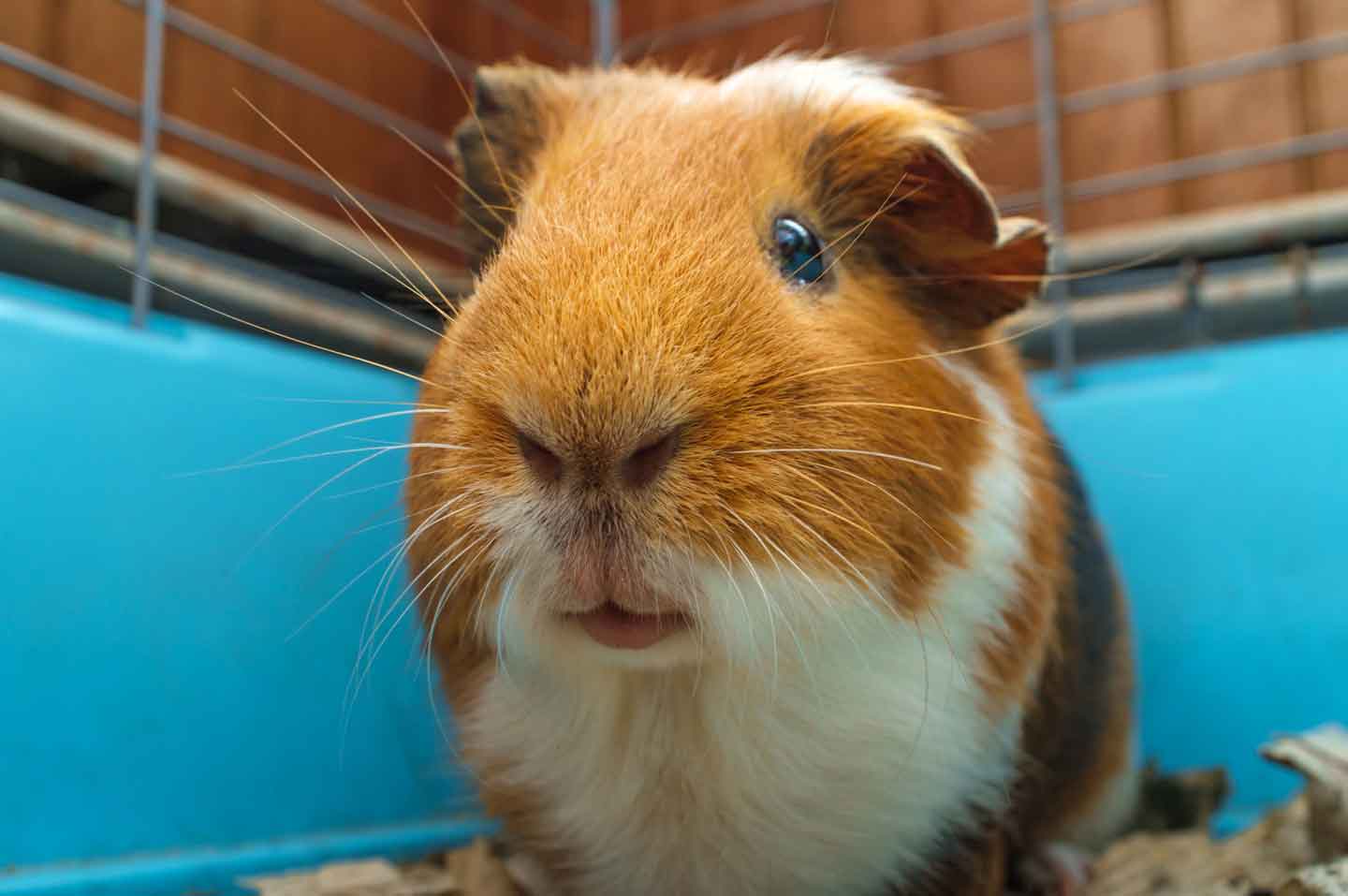
“A guinea pig’s cage should be located in a central area of the house, as many of them enjoy socializing with their human companions,” Dr. Cleary says. He recommends making sure their habitat has plenty of hiding areas to ensure shyer guinea pigs feel safe. Because loud noises can scare them, it’s also a good idea to keep the cage away from noisy areas.
When selecting a location for your guinea pig’s enclosure, it’s important to keep it out of direct sunlight or subject to any cold drafts. “They are most comfortable where humans are most comfortable,” Dr. Cleary says. An ideal temperature is 60–70 degrees Fahrenheit, up to 75 degrees maximum. (Hairless guinea pig breeds will require steady temperatures ranging from 72–75 degrees.) All guinea pigs can be at risk for heatstroke when temperatures reach 85 degrees, according to the Merck Veterinary Manual. It’s also best to keep the humidity levels under 50%.
Find out more about where to put your guinea pig cage.
Cleaning Your Guinea Pig Cage
A guinea pig’s cage should be fully cleaned at least every other day, with some older or more mobility-limited pigs possibly requiring up to twice-daily spot cleaning. Piggies housed in large cages may require less frequent cleanings.
Dr. Cleary provides these tips on cleaning your guinea pig’s cage:
- Remove and clean the cage liner, or switch it out with a clean one.
- Wash cloth liners with normal laundry detergent. Avoid bleach.
- Use a mixture of white wine vinegar and dish soap to clean the plastic floor and bars of the cage.
- Wash food bowls and water bottles daily.
- Clean off soiled toys at least once a week.
When cleaning your piggie’s habitat, you can place your guinea pigs in a playpen, Dr. Cleary says. “Many people will take the wire top of a standard cage and place it over the pigs on the floor to contain them while the interior of the standard cage is being cleaned,” he says. “This could also be a good time for other members of the family to hold or interact with the pigs to further socialize and bond with them.”
FAQs About Guinea Pig Housing
Q:Where is the best place to keep a guinea pig in the house?
A:Guinea pigs should be kept in an area where you spend a lot of time. Guinea pigs like attention. They should be kept away from extremes of heat or cold.
Q:Can guinea pigs live in a playpen instead of a traditional cage?
A:Yes, guinea pigs can live in a playpen. Make sure the bars are close enough that the guinea pig won’t try to squeeze out. Guinea pigs may not feel secure walking on wood floors or tile, so it’s best to provide them with secure footing, such as low-pile rugs or fleece.
Q:Can guinea pigs live in a multi-level cage?
A:Guinea pigs do best in a single-level enclosure on the ground. If they have a multi-level cage, they may fall off and get injured. Guinea pigs prefer being on the ground. Most guinea pigs will feel more comfortable if they have hiding places as well.
Providing guinea pigs with a large, clean space in a calm, quiet area in your home can help reduce their stress and promote a long, happy life. By helping these small pets feel comfortable and safe, you can earn their trust and form a strong bond you’ll both cherish for many years to come. They’ll be bound to show their appreciation for you in the form of uncontrollable popcorns and squeaky wheeks soon enough!
Expert input provided by Sari Kanfer, DVM, owner of Exotic Animal Veterinary Center in Pasadena, California; Lyle Cleary, DVM, veterinarian at The Center for Avian and Exotic Medicine in New York City.
This content was medically reviewed by Chewy vets.
More About Guinea Pigs
Share:
